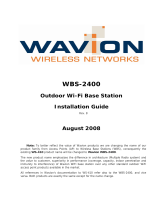Page is loading ...

i
Contents
H3C ANT-2506V-M6-E omnidirectional antenna installation guide ········································································ 1
Technical specifications ···················································································································································· 1
Safety precautions ····························································································································································· 4
Installation guidelines ······················································································································································· 4
Choosing a mounting location ········································································································································ 5
Mounting the antenna ······················································································································································ 5
Tools and equipment required ································································································································ 5
Mounting the antenna on a mast ···························································································································· 5
Recommended cable ················································································································································ 7

Manual Version:5PW100-20120627
1
H3C ANT-2506V-M6-E omnidirectional
antenna installation guide
Technical specifications
The ANT-2506V-M6-E antenna is designed for use in outdoor environments. It is connected to the
2.4-GHz or 5-GHz antenna port on an H3C outdoor AP through an N-type connector.
Figure 1 Antenna view
Table 1 Technical specifications
Antenna type ANT-2506V-M6-E
Operating frequency range 2400 MHz to 2483 MHz 5150 MHz to 5850 MHz
Bandwidth 83 MHz 700 MHz
Peak gain 6 dBi 8 dBi
Voltage standing wave ratio (VSWR) ≤ 1.5
Impedance 50 Ω
Polarization type Vertical
Max. power 20 W
Connector N-Female
Number of connector ports 6

Manual Version:5PW100-20120627
2
Dimensions 145 mm (5.71 in) diameter and 300 mm (11.81 in) length
Weight 1.2 kg (2.65 lb)
Operating temperature –40°C to +60°C (–40°F to +140°F)
Installation Mast mounting
Figure 2, Figure 3, Figure 4, and Figure 5 show the horizontal and vertical radiation patterns.
Figure 2 2.4-GHz horizontal pattern

Manual Version:5PW100-20120627
3
Figure 3 2.4-GHz vertical pattern
Figure 4 5-GHz horizontal pattern

Manual Version:5PW100-20120627
4
Figure 5 5-GHz vertical pattern
Safety precautions
W
ARNING!
• Installing antennas is dangerous. For your safety, follow the installation directions.
• Keep the antenna away from power source, street lamps, distribution box, or other places that may
cause electrical shock.
• Do not touch any power lines for your safety.
• Keep safety in mind when you select your installation site. Keep the antenna away from electric
power lines and other lines.
• Do not work alone when you install the antenna.
• If you need to raise the mast, work with other people to avoid bodily injury.
• Do not use a metal ladder. Do not work on a wet or windy day. Dress properly, for example, shoes
with rubber soles. Wear rubber gloves.
• If the antenna, antenna cable, or any other installation accessory drops, get away from it to avoid
bodily injury.
• If an accident, for example, electrical shock, occurs with the power lines, immediately call for
qualified emergency help.
Installation guidelines
The ANT-2506V-M6-E is designed to create a MIMO-omnidirectional broadcast pattern, and is
applicable to towers or building top. If the mounting location is on the side of a building or tower, the

Manual Version:5PW100-20120627
5
antenna pattern will be degraded on the building or tower side. Typically, the higher an antenna is
above the ground, the better it performs. Install the antenna vertically and mount it as high as possible.
Keep the antenna away from metal obstructions and wire mesh.
Choosing a mounting location
The ANT-2506V-M6-E is typically installed on a high position, such as tower or building roof, with a mast.
The higher an antenna is above the floor, the better it performs. If possible, use a cable as short as
possible to connect the antenna and AP.
Mounting the antenna
You can install the ANT-2506V-M6-E antenna on a mast. The installation accessories are provided
(installation tools are user provided). If you intend to install your antenna on another surface, you must
provide the appropriate installation accessories.
Tools and equipment required
Provided with the antenna:
• Four M8 hex nuts that have been attached to the antenna
• Two U-bolts
• Four M8 hex nuts
• Eight 8 mm (0.32 in) flat washers
• Eight 8 mm (0.32 in) spring washers
• One L-mounting bracket
• Two U-mounting brackets
User-supplied:
• One adjustable wrench
• One knife
• A cable tie
• Grounding cable
• Sealant tape and sealing clay
• One mast with a diameter of 40 to 80 mm (1.57 to 3.15 in)
Mounting the antenna on a mast
To mount the antenna on a mast:
1. Use four sets of M8 hex nuts, spring washers, and flat washers to attach the L-mounting bracket to
the antenna bottom.

Manual Version:5PW100-20120627
6
Figure 6 Attaching the L-mounting bracket to the antenna
(1) Grounding terminal (2) M8 hex nut, spring washer, and flat washer
(3) L-mountin
g
bracket
2. Place a U-bolt around the mast, and pass the U-bolt through the target installation holes on the
U-mounting bracket. Make sure the antenna is vertical to the ground.
3. Place a spring washer and flat washer on each end of the U-bolt, start an M8 hex nut on each end
of the U-bolt and tighten the nut with an adjustable wrench.
4. Repeat Steps 2 and 3 to attach the other U-bolt to the mounting brackets.

Manual Version:5PW100-20120627
7
Figure 7 Installing the antenna
(1) M8 U-bolt (2) U-mountin
g
bracket
(3) M8 hex nut, spring washer, and flat washer (4) L-mounting bracket
Recommended cable
H3C recommends that you use a high-quality, low-loss cable with the antenna. Coaxial cable loses
efficiency as the frequency increases, causing signal loss. Keep the cable as short as possible because
cable length also causes signal loss (the longer the run, the greater the loss).
/
